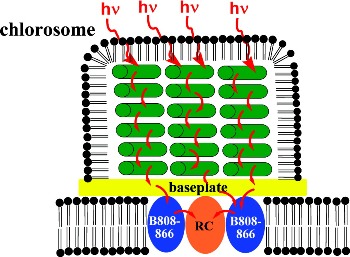A new study performed by the researchers from the Washington University in St. Louis and the Oak Ridge National Laboratory of the Department of Energy to analyze the structure of chlorosomes in green photosynthetic bacteria throws light on the development of biologically enlivened solar cell devices.
 Chlorosomes (shown in green) capture and transfer light energy to the reaction center for photosynthesis in bacteria
Chlorosomes (shown in green) capture and transfer light energy to the reaction center for photosynthesis in bacteria
Chlorosomes are known for their efficiency in harvesting sun light even in low light conditions and extreme weather conditions to convert it into energy. The researchers utilized small-angle neutron dispersion method with Bio-SANS instrument at the High Flux Isotope Reactor to study the construction of chlorosomes in green photosynthetic bacteria under a variety of thermal and ionic conditions. They found that the structure of the chlorosomes changed negligibly under all the conditions showing stability. The researchers consider the stability aspect as important to apply the research findings in the development of biohybrid applications such as development of a hybrid solar cell.
The scientists are finding ways to understand the functions of chlorosomes to imitate their functional efficiency in the creation of fully functional biohybrid solar cells. The scientists are further exploring the ways to understand how the large and complicated structure of chlorosomes draws the sun light over a large area and transfer it to the reaction center without energy loss enroute. They are looking forward to understanding the rules that allow the efficient catching, reaping and transfer of light. The methodology followed by the researchers enabled them to observe the intricate biological system at nano-scale level without inflicting damages to the samples.
The Research received assistance from the Photosynthetic Antenna Research Center, an Energy Frontier Research Center that receives funding from Department of Energy’s office of Science.